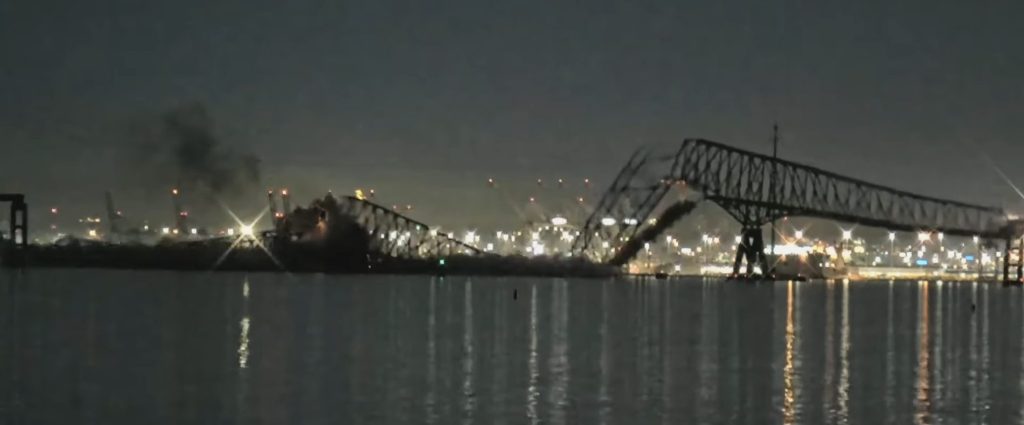Redirected Ships, Temporary Channels to Port of Baltimore, & Extended Operations at Alternate Ports – Bridge Collapse Updates
What’s been happening with shipping on the East Coast since the tragic collapse of the Francis Scott Key Bridge? I’m glad you asked. Let’s get into the updates…
Cargo Rerouting

There were close to 100 ships either headed for or scheduled for voyages that would call on the Port of Baltimore with more than 2,000 loads to be delivered there combined. The Port of Baltimore’s closure to ships disrupted all of that. Hundreds of loads have already been rerouted. Diversion of the remaining loads is still being worked out. Jasmina Ovcina Mandra reports specific numbers – as of Tuesday, April 2nd – in a World Cargo News article:
According to FourKites, the Dutch-based real-time supply chain visibility platform, as of March 29, 92 vessels with over 2,000 loads were either en route or had upcoming voyages into or out of the Port of Baltimore.
Of these loads, more than 1,400 are still slated for Baltimore but will now need to be rerouted due to the closure of the waterway. Already, over 600 loads have been redirected, with Savannah receiving the highest volume at 264 loads, followed by Norfolk with 181 loads, and New York with 70 loads.
Additional destinations include Port Everglades, Newark, Boston and Santos.
By all reports, the other East Coast ports are able to absorb the cargo that would normally be headed for the Port of Baltimore. Mandra specifically makes mention of the Port of New York and New Jersey, which ships that call on the Port of Baltimore often also call upon. However, just because the other ports are able to absorb the cargo movement, it doesn’t mean there is no delay.
While there are rumblings of larger delays, Mandra reports diversions are averaging an extended estimated delivery time of five days on imported goods. As we’ve talked about many times in the past, serious disruptions at one international shipping hub tends to ripple across supply chains around the world, impacting many others. In just one area where that can be seen, as ships that were routed to go through the Port of Baltimore are diverted, when they show up to other ports on their routes is affected and that can further impact the availability of ships for additional services.
There are plenty of complicating factors for carriers as they figure out and schedule ship and cargo diversions from the Port of Baltimore. However, it may be even more complicated for export cargo that has already arrived at the port. That cargo has to either wait for the port to open up in order to be exported out or it has to be picked up from the port and taken to another one in order to be shipped out. For many goods scheduled for export, the delays could easily stretch into weeks, and hard choices will have to be made about which cargo is prioritized.
Ports Expanding Hours to Handle Rerouted Cargo
Ships are already arriving in East Coast ports with diverted cargo, and plenty more will be coming. To accommodate, ports are extending hours to handle the cargo increase.
Peter Angell reported details on diverted cargo, adjusted services to handle it, and expanded port hours in a Journal of Commerce (JOC) article:
Most of the diverted ships are likely to call Port Newark Container Terminal (PNCT), which handles most of the Mediterranean Shipping Co. vessels calling New York-New Jersey. In response, PNCT is keeping its truck gates open until 6 pm, rather than closing at 4 pm, as of April 1. Starting April 6, PNCT will also open Saturdays from 7 am to 3 pm for an indeterminate period.
APM Terminals Port Elizabeth is also handling freight that would normally land in Baltimore. It received the 10,062-TEU Maersk Yukon and 8,238-TEU MSC Everest VIII on Thursday, both of which had been scheduled to call Baltimore over the next two weeks.
Next Tuesday, CSX Transportation is expected to start a daily north-south service from the New York-New Jersey port and its Kearny, NJ, intermodal terminal to Baltimore. According to people familiar with the operation, CSX will be running trains of approximately 6,000 feet that will be able to bring about 150 import containers to Baltimore’s Seagirt marine terminal for local pick-up and match back empties for the return trip.
…
The Port of Virginia said another diverted vessel, Evergreen Marine’s 14,354-TEU Triton, discharged an additional 1,103 containers that were originally bound for Baltimore during its regular call at the Virginia International Gateway terminal. The first of those containers was picked up on Friday. MSC is also diverting three of its vessels to Norfolk over the next week.
Similar to PNCT, Virginia is extending its gate hours, opening at 5 am instead of 6 am, Harris said. He also noted that about 80 Maryland-based trucking companies have recently registered to work at the port.
Temporary Channels to the Port of Baltimore & Reopening Timeline
Meanwhile, the unified command that has been assigned with responding to the Key Bridge collapse, which blocked off the waterway to the Port of Baltimore, has been creating alternate channels to the port. Two such channels have now been completed. A third is underway.
The initial channel was only 11 feet deep. That is not deep enough to accommodate the ships major carriers use to call upon the port. The second is a little deeper at 15 feet, but it is still nowhere near deep enough to open the port to the kinds of ships we’re used to seeing call.
Michelle Del Rey reports in the Independent on the third channel being made, a fourth that will be permanent, and a timeline that has now been given for the reopening of the port:
A third [channel], which officials say will be 35-feet deep and 280-feet wide, will open at the end of April. The fourth channel will be permanent and would allow for ships as big as the “Dali” to navigate themselves in and out of the harbour. The “Dali” crew members still remain stuck on board the ship.
The “Dali” she mentions is the massive container ship that crashed into the Key Bridge, collapsing it.
Here is the timeline Del Rey reported from a press release that put out just today:
In a press release issued on Thursday, officials announced a timeline from when they expect the Port of Baltimore to be fully reopened to commercial shipping traffic.
Currently, officials have created two temporary channels with depths of 11 and 15 feet. A third channel is expected to be completed by the end of the month.
According to the release, the passageway will be 280-feet wide and 35-feet deep. The permanent 700-foot wide, 50-foot deep channel will reopen by the end of May, officials estimate.
That means we’re looking at basically two months of the Port of Baltimore being effectively closed. Hopefully, things will go to plan and that timeline estimate won’t underestimate the time it takes to get the permanent channel completed and the Port of Baltimore able to receive ships normally again.





